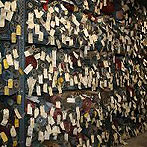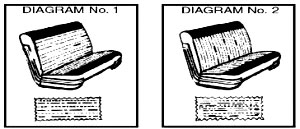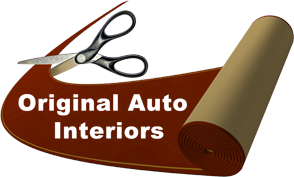N.O.S. Original Seat Cloth & Vinyl
 First, an explanation of the term “NOS,” or “New Old Stock” is in order. The materials are “new” in the sense that they have never been used in automotive seats or exposed to the conditions that cause materials to deteriorate, primarily sunlight and years of use. The materials are “old” because they have often been made the year before the issue of the vehicle.
First, an explanation of the term “NOS,” or “New Old Stock” is in order. The materials are “new” in the sense that they have never been used in automotive seats or exposed to the conditions that cause materials to deteriorate, primarily sunlight and years of use. The materials are “old” because they have often been made the year before the issue of the vehicle.
For example, a 1966 Ford cloth would have been produced in 1965 for construction of the vehicle’s original seat covers. The yardage is factory stock that was never used. It was quite common for the manufacturer to have material left over after a model or interior change, which occurred annually for most of the automakers.
Call to see if we have the original upholstery for your vehicle!
Determining Availability
Six methods of determining availability are commonly used:
- Telephone description of cloth by the customer, including pattern, color, year and model of the vehicle (this works well only for distinct patterned cloths).
- Sample sent by the customer for us to match (usually trimmed from an edge or the seam overlap inside the seat cover). This method is the most common and often necessary for most vinyl materials and very old cloths.
- A detailed, close-up photograph of the seat sent by the customer.
- We can forward (e-mail) photos of samples for identification and verification purposes.
- Detroit or De-Leo body cloth numbers. These numbers are part of a numbering system used by upholstery suppliers and do not correspond to any identifier used by the vehicle manufacturer. Often upholstery shops have access to these books, and by conferring with your upholstery person; it may not be necessary to send a sample.
- E-mail us at: origauto@tir.com with any of the above information.
Our Response Method
When we receive a sample from a customer, we identify the fabric and if available, cut a sample from our roll and send it to you along with the original sample. The sample will include pattern direction, price, and fabric width. Whether or not we have the material, we return the original sample. For our customers who indicate that they are pressed for time, we will call and indicate the availability and price. If the customer indicates that he/she is interested in a close match in the event that the original was not available, we search for an appropriate approximation of color and pattern, sending samples for approval. This may also be an option for the customer looking for an economical material to repair the seats in a daily driver. With an inventory as large as ours, on the rare occasion that the original is not available, something similar is.
Quality? Excellent!
A common question asked by our customers is, “If the material is 30 years old, is it any good? It’s not dry rotted is it?” Be assured that we do not sell fabrics that we would not be satisfied with in our own vehicles. If the fabric is dry rotted it goes in the trash. The original cloth, vinyl, and headliner yardage that we stock is stored with great care. Each fabric is carefully rolled on a sturdy tube and stored in controlled conditions until it is cut and rolled on to a tube for shipping. NOS material from Original Auto Interiors will wear as well as the fabric on the original seat frames. We cannot stress enough the excellent condition of these materials.
“How much do I need and how much do I have to buy?”
Normally cloth materials are produced on rolls wide enough to reach across the seat from door to door. In this case, the customer can simply measure the size of the insert from front to rear, measuring from seam to seam and adding 2 inches to allow for stitching. An exception to this rule is the “up the roll” material, in which the pattern direction goes into the roll as opposed to across the roll (see illustration). Our salespeople will assist you if this is the case.

“How much will it cost?”
Material prices vary considerably. Headliner yardage generally costs between $35 and $45 per yard, with the average being about $40. Vinyl materials generally cost between $50 and $65 per yard, with the average being about $55. Cloth materials generally cost between $85 and $99 per yard, with the average being about $89. Once we determine which material you need, we will provide a price quotation. Fabrics may be purchased in increments less than 1 yard, i.e.: 1/6, 1/3, 1/8, etc.

